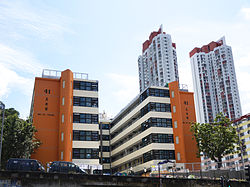| Shek Kip Mei | |||||||||||||||||
|---|---|---|---|---|---|---|---|---|---|---|---|---|---|---|---|---|---|
 Shek Kip Mei in 2009 | |||||||||||||||||
| Traditional Chinese | 石硤尾 | ||||||||||||||||
| Simplified Chinese | 石硖尾 | ||||||||||||||||
| Literal meaning | Gorge End | ||||||||||||||||
| |||||||||||||||||
| Shek Kap Mei | |||||||||||||||||
| Traditional Chinese | 石甲尾 | ||||||||||||||||
| Simplified Chinese | 石甲尾 | ||||||||||||||||
| |||||||||||||||||
Shek Kip Mei,originally known as Shek Kap Mei,[ citation needed ] is an area in New Kowloon,to the northeast of the Kowloon Peninsula of Hong Kong. It borders Sham Shui Po and Kowloon Tong.





